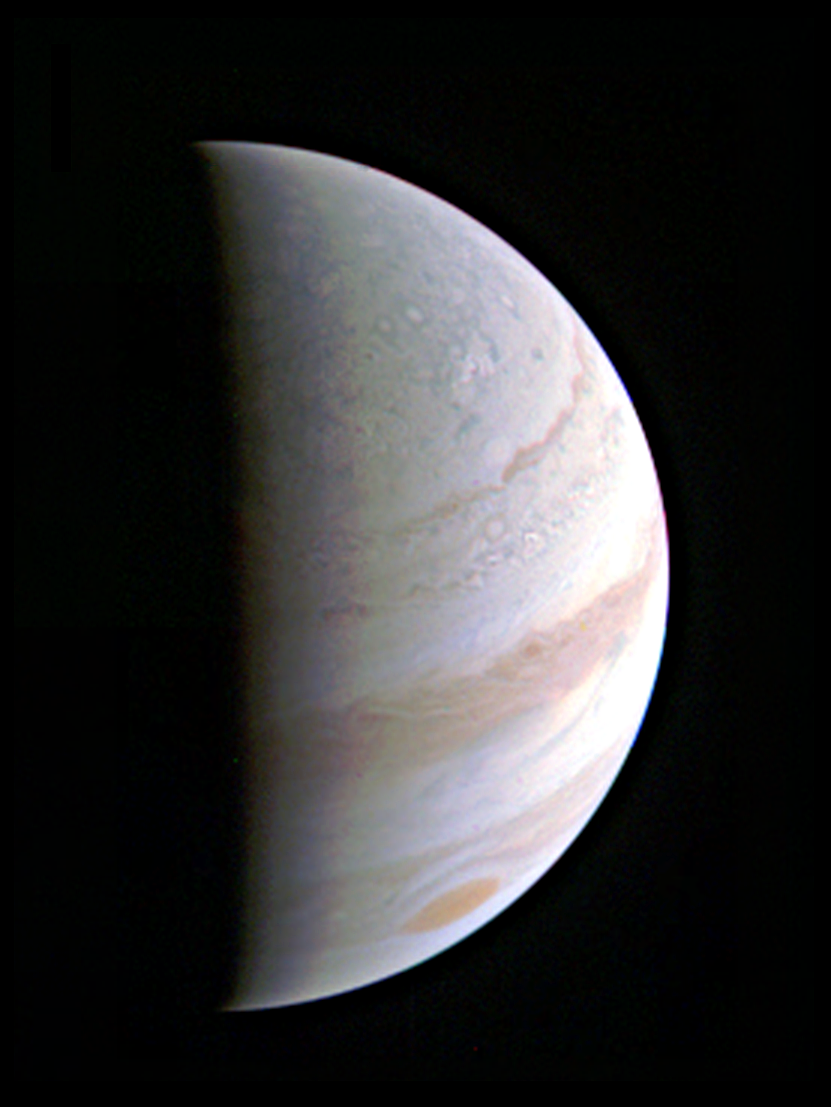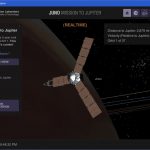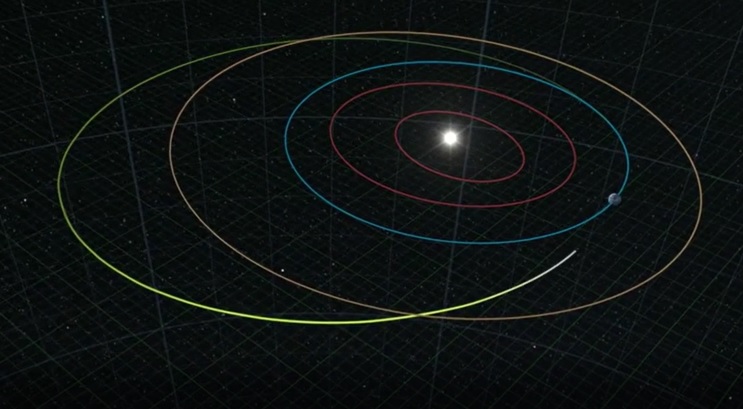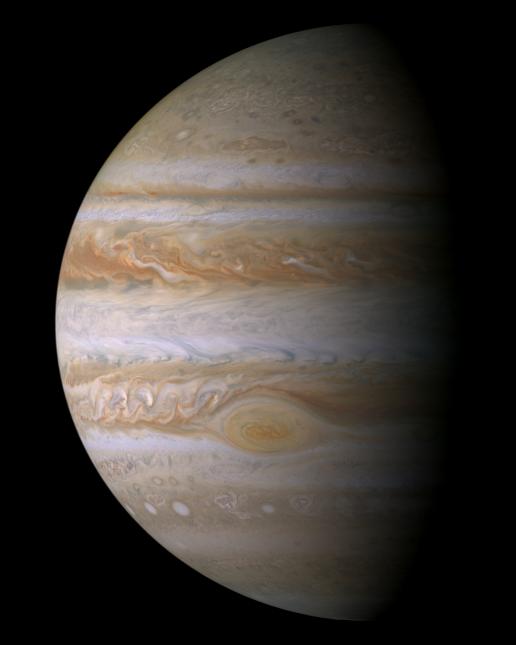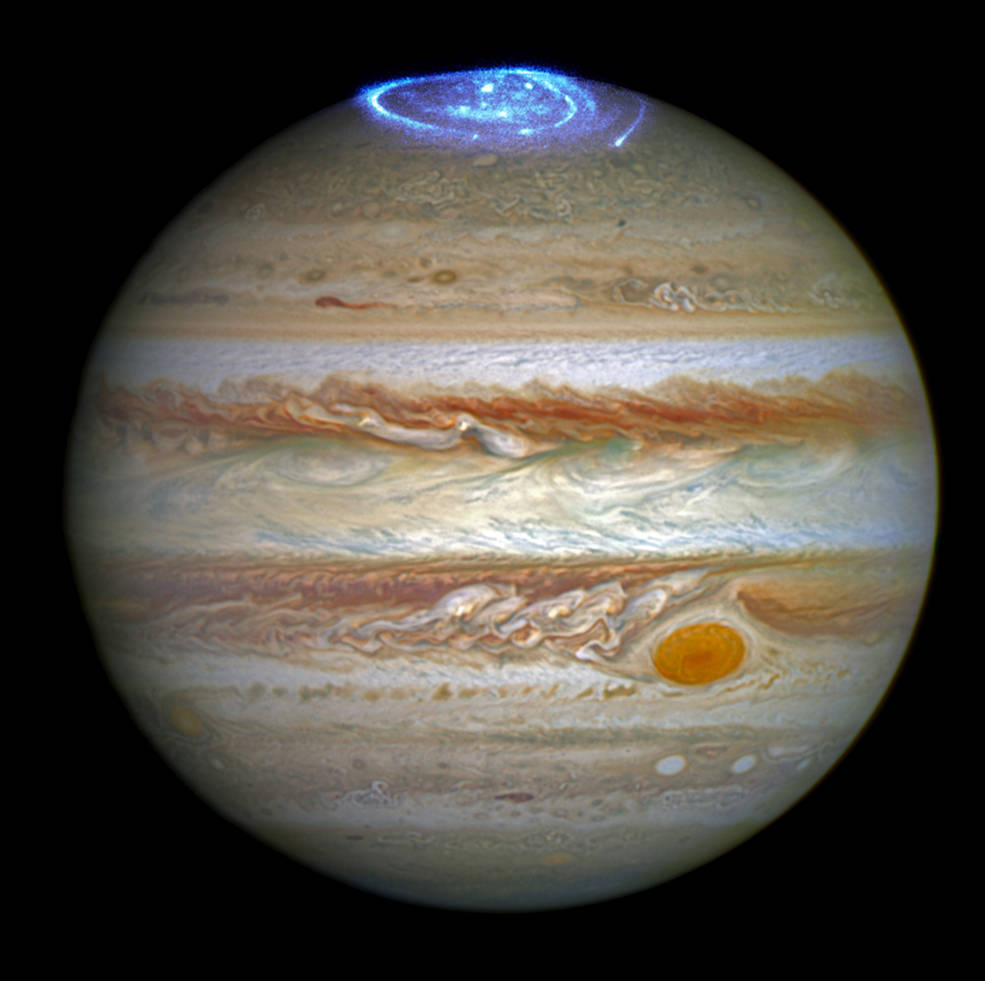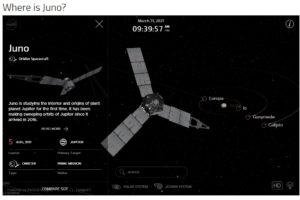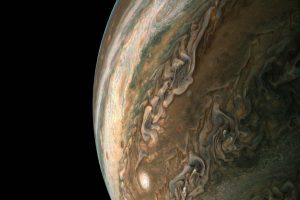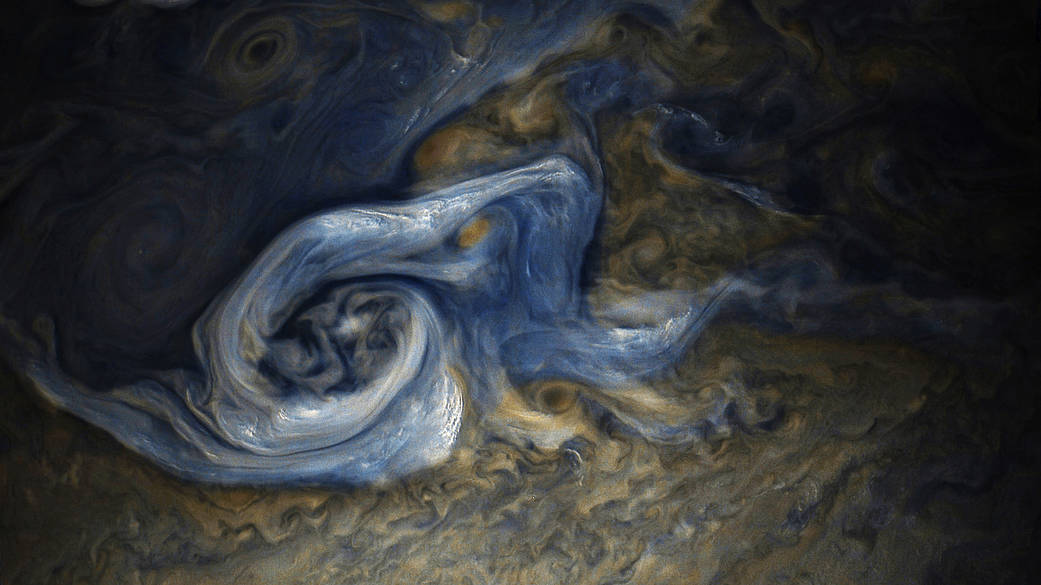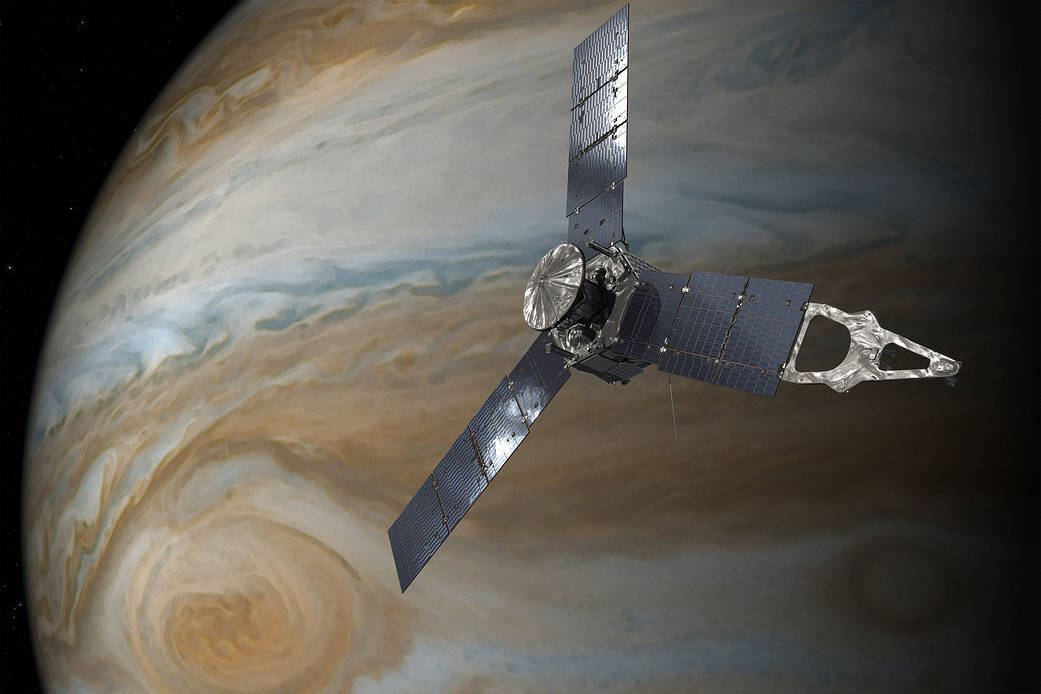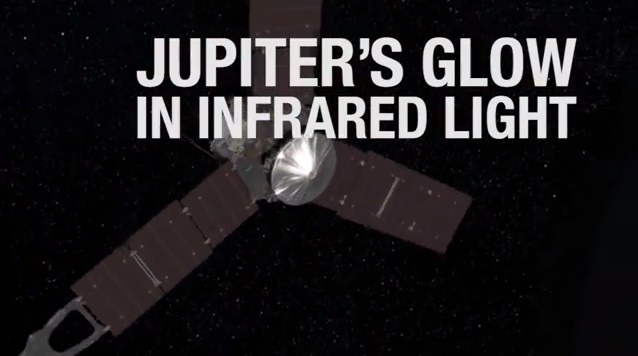Jupiter’s north polar region is coming into view as NASA’s Juno spacecraft approaches the giant planet. This view of Jupiter was taken on August 27, when Juno was 437,000 miles (703,000 kilometers) away.
Credits: NASA/JPL-Caltech/SwRI/MSSS
NASAの木星探査機ジュノーが、巨大惑星である木星に最接近すると、木星の北極が見えてきました。この画像はジュノーが8月27日に、木星から437,000マイル(703,000キロ)の地点から撮影しました。
オリジナル記事:NASA’s Juno Successfully Completes Jupiter Flyby
訳者注
NASAの木星探査機ジュノーの、木星最接近が無事成功したようです。
初めて見る木星のアップが1枚だけ公開されています。
いよいよこれから、木星の真の姿を見ることができそうです。
以下記事全文
NASA’s Juno mission successfully executed its first of 36 orbital flybys of Jupiter today. The time of closest approach with the gas-giant world was 6:44 a.m. PDT (9:44 a.m. EDT, 13:44 UTC) when Juno passed about 2,600 miles (4,200 kilometers) above Jupiter’s swirling clouds. At the time, Juno was traveling at 130,000 mph (208,000 kilometers per hour) with respect to the planet. This flyby was the closest Juno will get to Jupiter during its prime mission.
NASAのジュノーミッションは、今日木星の近くを通過し、最初の36日周期の軌道に入ることに成功しました。巨大ガス惑星(木星)に最接近した時刻は、PDT午前6時44分(EDT午前9時44分、UTC午後01時44分)で、木星の渦巻く雲の上約2600マイル(4200キロ)を通過しました。この時点では木星に対して毎時13万マイル(時速208,000キロ)で飛行していました。今回の近接通過は、ジュノーの最初のミッションの中では、最も木星に接近するものでした。
“Early post-flyby telemetry indicates that everything worked as planned and Juno is firing on all cylinders,” said Rick Nybakken, Juno project manager at NASA’s Jet Propulsion Laboratory in Pasadena, California.
「近接通過した直後の段階で、全てのものが計画通り作動していて、ジュノーは全て快調に動いていることを通信から確認しました。」と、カリフォルニア州パサデナにあるNASAのジェット推進研究所のジュノープロジェクトマネージャーの「リック・ニバッケンは話しています。
There are 35 more close flybys of Jupiter planned during Juno’s mission (scheduled to end in February 2018). The August 27 flyby was the first time Juno had its entire suite of science instruments activated and looking at the giant planet as the spacecraft zoomed past.
ジュノーのミッション(2018年2月に終了予定)中に木星への接近は35回以上計画されています。 8月27日の近接通過は、初めてジュノーが搭載している全ての科学観測機器を稼働させて、過去の探査機が拡大してみたような巨大惑星を、実際の大きさで見ることができたのです。
“We are getting some intriguing early data returns as we speak,” said Scott Bolton, principal investigator of Juno from the Southwest Research Institute in San Antonio. “It will take days for all the science data collected during the flyby to be downlinked and even more to begin to comprehend what Juno and Jupiter are trying to tell us.”
「前に私たちがお話ししたように、いくつかの素晴らしいデータを手に入れ始めています。」とサンアントニオのサウスウェスト研究所のジュノー研究者責任者である、スコット・ボルトンは述べています。「近接通過の間に収集されたデータを入手して、ジュノーと木星が私たちに伝えようとしていることを解釈するのには数日かかります」(補足:今回のデータを分析してまとめるのに数日かかるということ。スコットは、生の科学データを意味のある画像や数値にして公開できるのは翌週後半と話していました)
While results from the spacecraft’s suite of instruments will be released down the road, a handful of images from Juno’s visible light imager — JunoCam — are expected to be released the next couple of weeks. Those images will include the highest-resolution views of the Jovian atmosphere and the first glimpse of Jupiter’s north and south poles.
探査機の測定装置の観測結果を地球で受信して、ジュノー搭載の可視光カメラであるジュノーカムで撮影した幾つかの画像を公開できるのは、再来週になると思います。
“We are in an orbit nobody has ever been in before, and these images give us a whole new perspective on this gas-giant world,” said Bolton.
「私たちは誰もが今まで到達したことのない木星の軌道上にあり、これらの画像は私たちに、このガスの巨大惑星(木星)の全体像を、新たに見せてくれるのです。」と、ボルトンは言っています。
The Juno spacecraft launched on Aug. 5, 2011, from Cape Canaveral, Florida, and arrived at Jupiter on July 4, 2016. JPL manages the Juno mission for the principal investigator, Scott Bolton, of Southwest Research Institute in San Antonio. Juno is part of NASA’s New Frontiers Program, which is managed at NASA’s Marshall Space Flight Center in Huntsville, Alabama, for NASA’s Science Mission Directorate. Lockheed Martin Space Systems, Denver, built the spacecraft. Caltech in Pasadena, California, manages JPL for NASA.
ジュノー探査機は、2011年8月5日にフロリダ州ケープカナベラルから打ち上げられ、2016年7月4日に木星に到達しました。JPLは、ジュノーのミッションのためにサンアントニオのサウスウェスト研究所の研究者責任者のスコット・ボルトンを管理します。ジュノーは、NASAの科学ミッション本部に属し、アラバマ州ハンツビルにあるNASAのマーシャル宇宙飛行センターにて管理されているNASAのニューフロンティアプログラムの一部です。デンバーにあるロッキード・マーチン宇宙システムでは、探査機が製造されました。カリフォルニア州パサデナのカリフォルニア工科大学は、NASAのためにJPLを管理しています。
More information on the Juno mission is available at:
http://www.nasa.gov/juno
ジュノミッションの詳細は、以下の場所にあります:
http://www.nasa.gov/juno
The public can follow the mission on Facebook and Twitter at:
http://www.facebook.com/NASAJuno
Tweets by NASAJuno
ミッションについてはフェイスブックとツイッターで公開しています。
http://www.facebook.com/NASAJuno
http://www.twitter.com/NASAJuno
DC Agle
Jet Propulsion Laboratory, Pasadena, Calif.
818-393-9011
agle@jpl.nasa.gov
Dwayne Brown / Laurie Cantillo
NASA Headquarters, Washington
202-358-1726 / 202-358-1077
dwayne.c.brown@nasa.gov / laura.l.cantillo@nasa.gov
2016-225
Last Updated: Aug. 28, 2016
Editor: Tony Greicius
